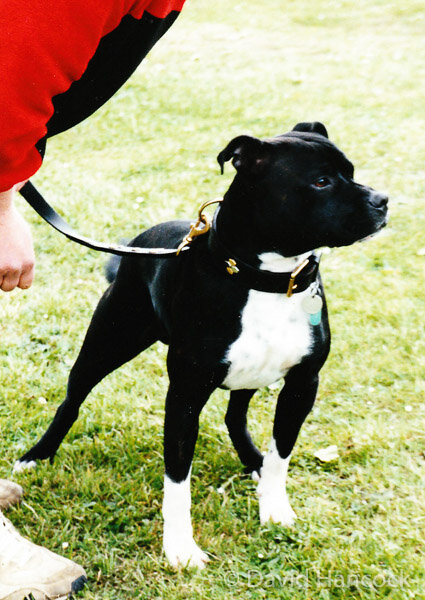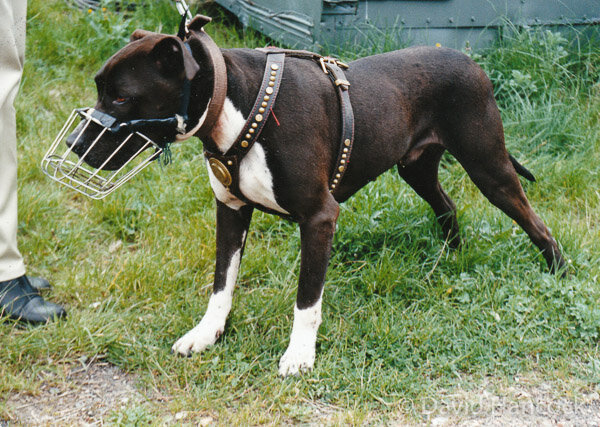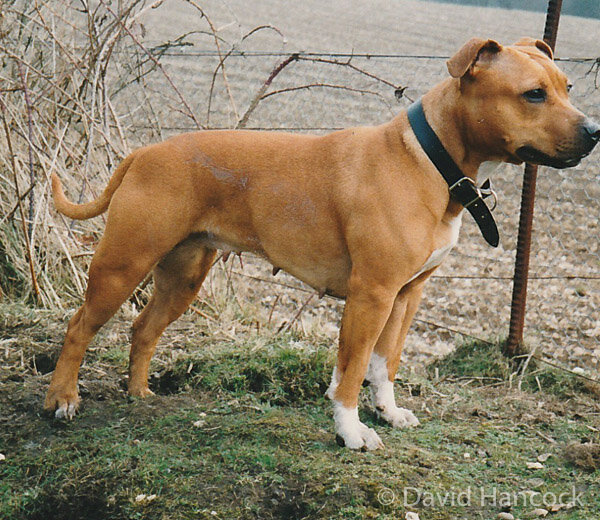1169
WHAT IS A DANGEROUS BREED OF DOG?TITLE
By David Hancock
In The Sunday Telegraph of the 25th of November 2018, a piece by Patrick Sawyer and Patrick Scott and headlined “Half of danger dogs destroyed ‘harm no one’”, they highlighted the needless cruelty, even death, inflicted on totally harmless pet-dogs because of the failings and limitations of the ill-phrased, ill-conceived Dangerous Dogs Act of 1991. Their article pointed out that the latest available figures show that in 2015-16, a total of 307 dogs were destroyed after being seized, but that 175 of these would be widely regarded as ‘innocent’. They also pointed out that the majority of dogs seized during that period, 599 out of a total of 731, had not attacked anyone or shown any signs of dangerous intent. They quote the charity Born Innocent in stating that in the past eight years, £3 million has been spent on kenneling seized dogs and more than £5 million on police costs for investigations and prosecutions. The police of course can decide whether a dog belongs to one of the banned breeds, despite not one of the breeds named in the Act being registered with the Kennel Club as a recognized breed. The police are allowed to use their own criteria in deciding whether a seized dog belongs to one of the banned breeds, despite having zero expertise on breeds of dog and having no hope at all of identifying a member of the overseas breeds named in this shameful Act. In letters I once exchanged with the Head of the Metropolitan Police Dog Unit, the criteria for breed identification used by them, to decide a dog’s fate, verged, to me, on the absurd.
The infamous Dangerous Dogs Act of 1991 is now known to dog lovers all over the world as one which shames Britain's judicial system, undermines our reputation as a nation of dog-lovers and sabotages our standing as a nation once famed for its level-headedness and disinclination to panic when under pressure. It is widely accepted by even the press now as a piece of knee-jerk legislation passed in an over-reaction to sensationalised newspaper articles. No dog-lover wants to see dogs that are truly dangerous threatening the well-being of citizens but legislation produced to remedy a situation surrounded by exaggeration, half-truths and ignorance has to be especially sound. The wording of this Act however reflects badly on those bodies which contributed to its substance and final form. So far, these bodies have managed to duck the missiles being rightly thrown by enraged individuals wronged by this faulty legislation and by their vocal and articulate supporters. The flaws in this Act do however reveal the incompetence of the so-called authorities who were mistakenly consulted by a weak government.
The Act stipulates consultation "with such persons or bodies as appear...to have relevant knowledge or experience, including a body concerned with animal welfare, a body concerned with veterinary science and a body concerned with breeds of dogs." The DDA was issued as an 'Act to prohibit persons from having in their possession or custody dogs belonging to types bred for fighting...' The DTI then produced Notices to Importers prohibiting the importation of 'Fighting Dogs', proscribed the Japanese Tosa as well as the Pit Bull Terrier, and later banned the Dogo Argentino and the Fila Brasileiro. Two out of the four 'types' mentioned were not bred for fighting and the Tosa was developed for 'dog-pinning' or ‘mouth-wrestling’ rather than dog-fighting as commonly perceived. The DDA did not, thankfully, ban breeds long accepted to have been originally bred for fighting, like the Bull Terrier, the Staffordshire Bull Terrier and the Chinese Fighting Dog, the Shar Pei. Strangely, the American Staffordshire Terrier, genetically identical with the Pit Bull Terrier – but specifically bred for sound temperament, is not nominated for a ban under this legislation.
This means however that the wording of the Act is instantly self-contradicted by the choice of breeds or breed-types in it. Who can have any confidence at all in 'the body concerned with breeds of dogs' who gave such ill-informed advice? And who was that body? Why, the Kennel Club, whose mandate is summed up as 'the improvement of dogs'! And who was the 'body concerned with animal welfare' consulted by HM Government? Why, the RSPCA, whose mandate does not include the protection of humans? What knowledge can either of these bodies have of the three foreign breeds they helped to have banned, breeds not even recognised by the KC as breeds and virtually unknown in Britain? Breeds or types of dogs can resemble each other very closely, as depictions of Staffordshire Bull Terriers, so-called Irish Staffies, American Staffordshire Terriers and Pit Bull Terriers demonstrate very convincingly.
The 'body concerned with veterinary science' has admitted that its graduates are not trained to identify breeds of dog. Our learned judiciary then accepts, as expert evidence, opinions from graduates of that body when trying to establish the breed of an accused dog in court. In this charade, these self-appointed experts are assisted by other non-experts in this field from a society pledged to prevent cruelty to animals, in order to obtain the execution of one wretched dog. From this authorised madness, "Malice in Wonderland" would make a good tear-jerker for any film-maker who loves satire. Sadly, enjoyable satire is not the outcome; commendably the BVA and the RSPCA are having second thoughts about this shameful Act.
But what about 'the body concerned with breeds of dog' which helped shape this monstrous Act and must have led on the subject of breeds? Let's take a look at the breeds the KC recommended to the Home Secretary for a ban: the Japanese Tosa, the Fila Brasileiro and the Dogo Argentino. The original fighting dog in Japan was the Akita. (Is it wise to let the Home Office's adviser on breeds of dog actually know this!) Places like Akita and Kochi are infamous for the popularity of dog-fighting there. The first Shar Pei I saw was in a Hong Kong street market and was described as a ‘Chinese Boxer’ – the local police told me that they were used locally in dog-fights! At one time, the bigger Akita dogs from the best hunting lines were almost spoiled by infusions of outside blood to increase size and power. Much of this came from the newly-developed Tosa dogs, created from Mastiff, Bulldog and St Bernard blood.
However distasteful they are, the dog v dog contests of Kochi Beach are a world apart from the bloody bull-and-terrier matches of previous centuries in Britain. When a Tosa pins another Tosa to the ground by the throat, it is performing the classic demonstration of supremacy in the broad-mouthed breeds, whose jaws are made for gripping not tearing or slashing. Other, much more undesirable contests between cross-bred dogs usually with Pit Bull Terrier blood, in Japan, are for the bloodthirsty spectators and they deservedly attract the attention of JAWS (Japan Animal Welfare Society) under Law 103 of 1973. However much we disapprove of any dog v. dog contest, it is wrong to assume that the Japanese Tosa is an aggressive, savage, ferocious, easily enraged dog-fighting breed. It is not. The Japanese have listed this breed as a 'national treasure' and it is recognised by the FCI and the AKC without reservation. But in recommending the banning of it our KC thinks it knows best.
The second outlawed breed, the Fila Brasileiro, is the 'holding dog' of Brazil, just as the Bullmastiff is here, the Dogue de Bordeaux in France, the Boerboel in South Africa, the Cane Corso in Italy and the Perro de Presa in the Canary Islands. Such dogs are not suitable as fighting dogs because they evolved as 'gripping' or 'holding' dogs for hunters and butchers; a dog fight involving two holding dogs would hardly please the bloodlusting social misfits who want contests giving lots of gore, not a 'pinning to the floor' competition. The Fila, whilst not exactly a soft touch for other dogs, was not 'bred for fighting', as the DDA asserts. It is in fact the national breed of Brazil and the Brazilians are greatly offended that 'their' breed is wrongfully banned here.
The Fila is a large, powerful dog, 27" at the shoulder and 140lbs in weight, developed from various mastiff breeds from Western Europe and the original St. Hubert hound, much bigger than the contemporary Bloodhound. Muscular, heavy-boned dogs, with the characteristics of the broad-mouthed group of dogs, there are around 3,000 in the United States, where the AKC accepts that they are not dangerous and recognises them as a rare breed. The FCI recognised the breed in 1968, clearly happy with their sociability. The Fila is now the most popular breed in Brazil, with more than 8,000 registered each year. But our KC when advising the banning of it clearly think they know better than any Brazilian on the subject of their revered national breed, it would seem.
The Fila is a protective breed which is by nature wary of strangers but devoted to its family. Is that not desirable in a watchdog or guard-dog? I can find no record of their having been bred for fighting. The Brazilians have a saying "as faithful as a Fila". When I see this 'banned as dangerous’ breed at foreign shows, being handled without difficulty by slender ladies or minded by small children, I shake my head and wonder what my own country is coming to; a land fit for bossy bureaucrats and toadying politicians perhaps. We are becoming frightened of our own shadows. Are Brazilians really less responsible dog owners than we British? What arrogance to ban their breed without any experience of it!
The Dogo Argentino, also outlawed here, is probably the best living example of the Alaunts, the huge white hunting mastiffs favoured by mounted hunters in medieval times. Used to hunt pumas and wild hogs in small packs, these Argentinian hounds are hardly likely to be successful packhounds if they are predisposed to fight each other. As a breed they were developed for the hunting field; they were not bred to fight. Their ancestors were fighting dogs, just as were those of our Bull Terriers and Staffordshire Bull Terriers. In developing the Dogo Argentino, Antonio Martinez blended the blood of the old Cordoba fighting dogs, descended from imported Spanish Alanos (resembling big Bulldogs), with that of white French Pointers, 'Bullenbeissers' from Germany (the ancestors of the Boxer), Irish Wolfhounds and Pyrenean Mastiffs. He was seeking hunting dogs with good noses, great determination and ample stamina. He did not want huge white savage dogs which spent most of their time fighting each other and therefore making themselves unfit to hunt. A dog expected to hold on to a 150lb wild boar until the hunters arrive has to be brave, immensely determined and not get into a frenzy, as the old fighting dogs used to.
The modern breed of Dogo Argentino contains all the desirable qualities of its ancestors and any undesirable ones cropping up are bred out. Our Bull Terrier breeders do the same, with excellent results. The International Kennel Club, the FCI, recognised the Dogo in 1973. Dog fighting is banned in Argentina. When clandestine meetings are held, American Pit Bull Terriers are used because the Dogo Argentino is not sufficiently savage. If the Argentinians banned our beloved Bull Terrier, it would be unjustified and quite outrageous. But we proscribe their national breed as a dog bred for fighting, and therefore dangerous, in the absence of any evidence of this, on the 'expert' advice of the KC, which has no experience of the breed. We have saddled ourselves with an unjustified law and have earned ourselves the contempt of international dogdom. But it would take a blood-sample to decide whether a huge fawn mastiff-type dog was a Japanese Tosa, a Fila Brasileiro or a Broholmer from Denmark. Similarly, a big white Bull terrier looks just like a Dogo Argentino. But breeds are not the problem, temperament in each dog is!
Behind this ill-conceived ill-fated Act there is considerable dishonesty. Most dog-bites are committed, not by Pit Bull Terriers, but by Jack Russells, German Shepherd Dogs and various 'collies' or by dogs which look more like them than anything else. Tactfully and tactically, but less logically, no action has been taken against the breeds with those names and I support that. But that is tactics ahead of honesty; administrators want to avoid taking on the huge GSD, Jack Russell and collie lobby. It also makes nonsense of the stated desire to protect the public from dogs which bite. The breeds banned under this law have no evidence against them, as pedigree breeds, of biting incidents which might justify a ban. The body concerned with breeds of dog which advised the Home Office to ban this so-called dangerous group of dog breeds acted without evidence and beyond their knowledge. Bull Terrier hybrids have been destroyed in a number of places ‘because they looked like Pit Bulls’! But dogs used for fighting have to be fast not heavily-muscled as many misguided enthusiasts have publicly stated for many years.
But the police too have a case to answer, not just on how the Act has been implemented but in being honest about exactly what they wanted from such legislation. No rational person wants to see policemen harmed by deranged Pit Bull Terriers owned and intentionally deployed by criminals. The Pit Bull Terrier has greater jaw strength than any other breed-type and in the wrong hands is a greater menace. Any dog used offensively by criminals as an attack dog must be shot. But does legislation to achieve that have to condemn blameless family pets? If you look in the advertisement columns covering dogs for sale in certain periodicals, you can soon spot the worrying new hybrids being created by the criminally-inclined - and they don't look like Pit Bull Terriers. American Bulldogs suddenly became all the rage, with a Welsh Mastiff being developed and Boerboels brought in from South Africa. If the police themselves need protection from dangerous dogs, then the last thing they should do is target certain breeds. The criminal fraternity just create savage canine psychopaths another way. All dogs must be judged on their deeds.
So what has the DDA achieved? A number of things, none of them good: the destruction of harmless innocent family pets; a distinct undermining of our respect for the law; scorn for thoroughly bad court judgements; the Kennel Club and the RSPCA being discredited; the Home Office shewn to lack stature; the police shamed; overseas dog lovers astonished and dismayed by our national stupidity and, especially recently, growing public unease. Not bad from just one Act! But with tragic consequences for some dogs this Act has been mirrored in quite a number of overseas countries from North America to Northern Europe. Our ill-framed Act has 'inspired' parallel legislation, based on similar falsehoods. All over the western world, once again, dog is suffering from human stupidity; when will it end? Already imported breeds such as the Boerboel and the American Bulldog have been victims of misidentification by untrained police forces. Whatever breed of dog you favour, don’t let it resemble a sturdy Staffie, a muscular Bull Terrier or having the anatomy that the police service has declared as ‘dangerous’ however temperamentally trustworthy or equable mentally!



























